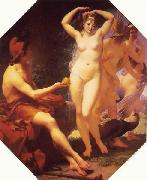Wholesale Oil Painting No Minimum |
|||||||||||
|
|
|||||||||||

|
|||||||||||
|
|
|
||||||||
Baron Jean-Baptiste RegnaultParis 1754-1829 French painter. His first teacher was the history painter Jean Bardin, who took him to Rome in 1768. Back in Paris in 1772, he transferred to the studio of Nicolas-Bernard Lepicie. In 1776 he won the Prix de Rome with Alexander and Diogenes (Paris, Ecole N. Sup. B.-A.) and returned to Rome, where he was to spend the next four years at the Academie de France in the company of Jacques-Louis David and Jean-Francois-Pierre Peyron. While witnessing at first hand Peyron's development of a manner indebted to Poussin and David's conversion to Caravaggesque realism, Regnault inclined first towards a Late Baroque mode in a Baptism of Christ (untraced; recorded in two sketches and an etching), then, in Perseus Washing his Hands (1779; Louisville, KY, Speed A. Mus.), to the static Neo-classicism of Anton Raphael Mengs. |
||||||||
|
|
||||||||
The judement of Paris
The judement of Paris Painting ID:: 91112 |
1820(1820)
Medium oil on canvas
cyf 1820(1820) Medium oil on canvas cyf |
|||||||
|
|
||||||||
|
William Etty 1787-1849 English William Etty Location English painter. Born into a Methodist family, he was the seventh child of a miller and baker in Feasegate, York, and in 1798 he was apprenticed as a printer to Robert Peck, publisher of the Hull Packet. Financial support from his uncle, a banker, allowed him to go to London in 1805, where he entered the Royal Academy Schools in 1806. For a year, in 1807-8, he was a pupil of Thomas Lawrence, who greatly influenced him. Following the death of his uncle in 1809 he became financially secure. From 1811 he exhibited regularly at the Royal Academy and the British Institution and in 1816 worked in the studio of Jean-Baptiste Regnault in Paris. The judement of Paris 1787-1849 Medium oil on canvas Dimensions ? X ? cm cyf |
||||||||
|
|
||||||||
|
Prev Next
|
||||||||
|
|
||||||||
|
Related Paintings to William Etty :. |
||||||||
|
|
||||||||
|
CONTACT US |

